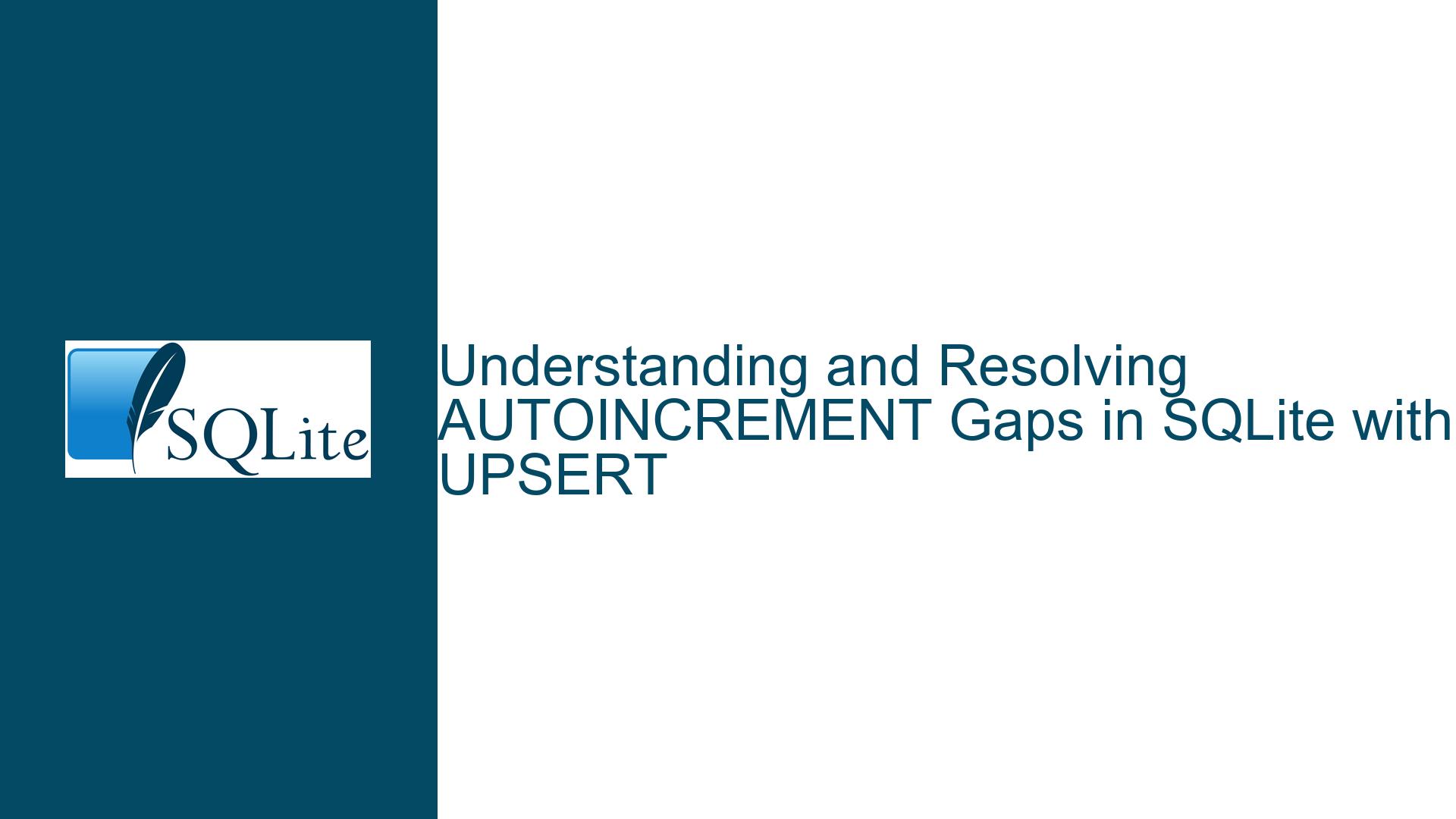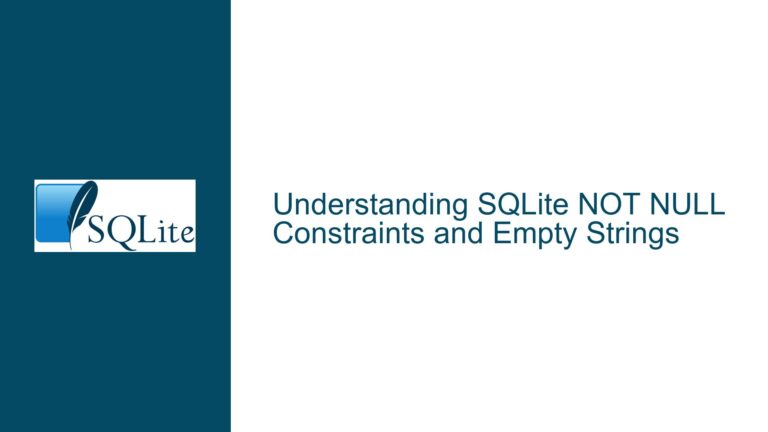and Resolving AUTOINCREMENT Gaps in SQLite with UPSERT
AUTOINCREMENT Behavior with UPSERT Causing ID Gaps
When working with SQLite, a common scenario involves using the AUTOINCREMENT keyword to automatically generate unique primary keys for a table. However, when combining AUTOINCREMENT with the UPSERT clause (specifically, INSERT ... ON CONFLICT), users may observe unexpected gaps in the sequence of generated IDs. This behavior can be confusing, especially when the expectation is that the primary key values will be sequential without any missing numbers.
For example, consider a table vocabulary with the following schema:
CREATE TABLE vocabulary (
id INTEGER PRIMARY KEY AUTOINCREMENT,
word TEXT UNIQUE,
count INTEGER DEFAULT 1
);
When performing multiple INSERT operations with the ON CONFLICT clause, such as:
INSERT INTO vocabulary(word) VALUES('one') ON CONFLICT(word) DO UPDATE SET count=count+1;
INSERT INTO vocabulary(word) VALUES('one') ON CONFLICT(word) DO UPDATE SET count=count+1;
INSERT INTO vocabulary(word) VALUES('one') ON CONFLICT(word) DO UPDATE SET count=count+1;
INSERT INTO vocabulary(word) VALUES('two') ON CONFLICT(word) DO UPDATE SET count=count+1;
INSERT INTO vocabulary(word) VALUES('two') ON CONFLICT(word) DO UPDATE SET count=count+1;
INSERT INTO vocabulary(word) VALUES('two') ON CONFLICT(word) DO UPDATE SET count=count+1;
The expected result might be:
| id | word | count |
|---|---|---|
| 1 | one | 3 |
| 2 | two | 3 |
However, the actual result could be:
| id | word | count |
|---|---|---|
| 1 | one | 3 |
| 4 | two | 3 |
In this case, the id values 2 and 3 are skipped, leading to gaps in the sequence. This behavior is directly related to how SQLite handles AUTOINCREMENT and UPSERT operations.
How UPSERT and AUTOINCREMENT Interact to Create ID Gaps
The root cause of the ID gaps lies in the interaction between the AUTOINCREMENT mechanism and the UPSERT operation. When an INSERT statement is executed with the ON CONFLICT clause, SQLite first attempts to insert a new row. If a conflict occurs (e.g., due to a uniqueness constraint), the ON CONFLICT clause triggers an update to the existing row instead of inserting a new one.
However, during this process, SQLite generates a new ROWID (or AUTOINCREMENT value) for the attempted insert, even if the insert ultimately fails and is converted into an update. This generated ROWID is then "consumed," meaning it will not be reused in subsequent insert operations. As a result, gaps can appear in the sequence of ROWID or AUTOINCREMENT values.
This behavior is documented in the SQLite documentation, which states that AUTOINCREMENT guarantees that automatically chosen ROWIDs will be monotonically increasing but not necessarily sequential. Gaps can occur due to failed insert attempts, deletions, or other operations that cause ROWIDs to be skipped.
Strategies to Avoid or Manage AUTOINCREMENT Gaps in UPSERT Scenarios
To address the issue of ID gaps when using AUTOINCREMENT with UPSERT, several strategies can be employed. Each approach has its own trade-offs, and the best solution depends on the specific requirements of the application.
Dropping AUTOINCREMENT for Sequential IDs
One straightforward solution is to drop the AUTOINCREMENT keyword and rely on SQLite’s default behavior for primary keys. When a column is defined as INTEGER PRIMARY KEY without AUTOINCREMENT, SQLite will automatically assign a unique ROWID that is typically sequential, but it may reuse ROWIDs from deleted rows. This approach can help avoid gaps in the sequence, but it does not guarantee that ROWIDs will always be increasing, especially if rows are deleted.
For example, modifying the vocabulary table schema as follows:
CREATE TABLE vocabulary (
id INTEGER PRIMARY KEY,
word TEXT UNIQUE,
count INTEGER DEFAULT 1
);
With this schema, the id values will generally be sequential, but gaps may still occur if rows are deleted.
Using a Separate Sequence Table
Another approach is to manage the sequence of IDs manually using a separate sequence table. This table can store the next available ID, and the application can explicitly retrieve and increment this value before performing an insert. This method provides full control over the ID sequence and can ensure that no gaps occur.
For example, creating a sequence table:
CREATE TABLE sequence (
name TEXT PRIMARY KEY,
next_id INTEGER DEFAULT 1
);
Before inserting a new row into the vocabulary table, the application can retrieve and increment the next_id value from the sequence table:
BEGIN TRANSACTION;
UPDATE sequence SET next_id = next_id + 1 WHERE name = 'vocabulary';
INSERT INTO vocabulary(id, word) VALUES((SELECT next_id - 1 FROM sequence WHERE name = 'vocabulary'), 'one') ON CONFLICT(word) DO UPDATE SET count=count+1;
COMMIT;
This approach ensures that IDs are assigned sequentially without gaps, but it requires additional logic and can introduce complexity, especially in multi-user environments where concurrent inserts may occur.
Accepting Gaps as a Natural Part of AUTOINCREMENT
In some cases, it may be acceptable to allow gaps in the ID sequence. If the primary key’s only purpose is to uniquely identify rows, and the actual value of the key is not important, then gaps can be ignored. This approach simplifies the schema and avoids the need for additional logic to manage ID sequences.
For example, continuing to use the original schema with AUTOINCREMENT:
CREATE TABLE vocabulary (
id INTEGER PRIMARY KEY AUTOINCREMENT,
word TEXT UNIQUE,
count INTEGER DEFAULT 1
);
With this schema, gaps may occur, but they do not affect the functionality of the table. The id values will still be unique and monotonically increasing, which is often sufficient for most applications.
Using a Custom UPSERT Implementation
For applications that require strict control over the ID sequence and cannot tolerate gaps, a custom UPSERT implementation can be developed. This approach involves checking for the existence of a row before performing an insert and only incrementing the ID if a new row is actually inserted.
For example, the following pseudocode demonstrates a custom UPSERT implementation:
BEGIN TRANSACTION;
SELECT id FROM vocabulary WHERE word = 'one';
-- If the row exists, perform an update
UPDATE vocabulary SET count = count + 1





